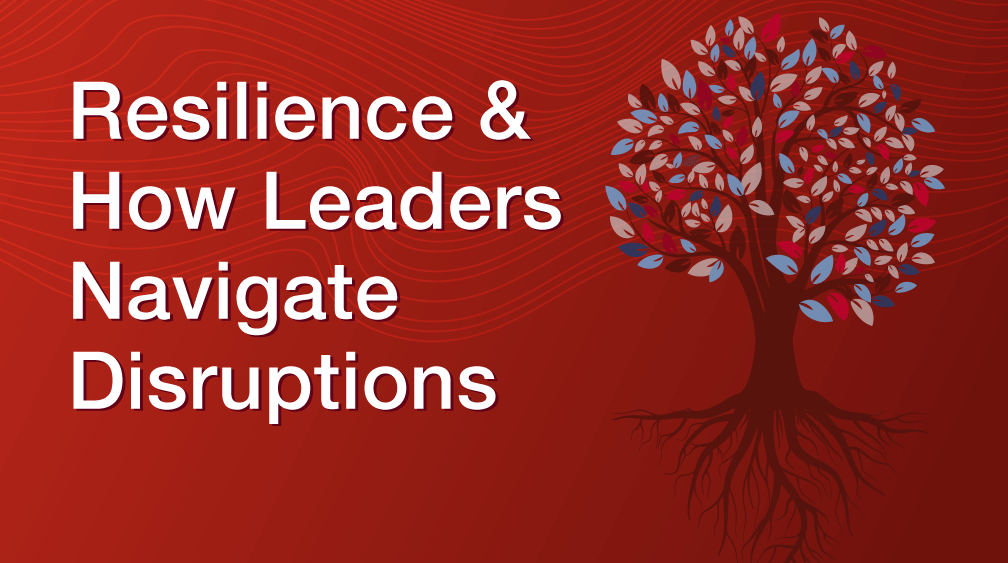It can be lonely as a leader, especially right now during times of unprecedented disruption. Leaders must make decisions that sometimes only they can make. This includes knowing what to communicate, how to attend to teams’ needs that can vary so vastly, which strategies to employ, and how to plan for the long-term.
In this blog, we will explore the role of resilience in strengthening leadership and organizations in times of uncertainty. In order to understand and continue to build our resilience, we need to explore what resilience is, how to think about it, and which principles of resilience we can apply – not only to survive but to thrive in our current environment.
Our working definition of resilience is the “capacity of a system, enterprise, or person to maintain its core purpose and integrity in the face of dramatically changed circumstances” (Resilience: Why Things Bounce Back by Andrew Zolli).
Resilience opens the door to new possibilities for you and your organization. These possibilities include developing new skills and habits, reinforcing and/or shifting cultural norms, and creating innovative products and services. When you as a leader can remain intentional and deliberate, there is a tremendous opportunity to define and build the “next normal” in which your teams and organizations can truly flourish.
How can you build resilience? There are actions you can take today to help your teams and organization thrive using six principles to better navigate systemic shocks in a way that builds resilience. This blog covers the first three principles. For the full text, download our Leader’s Guide to Resilience designed to help leaders strengthen themselves and their organizations in times of uncertainty.
Choose your attitude
Viktor Frankl, an Austrian neurologist, psychiatrist, and Holocaust survivor said that choosing your attitude, even in the most abysmal circumstances, leads us to freedom and an opportunity to create our own meaning (Man’s Search for Meaning by Viktor Frankl). As a leader, you have an opportunity to set the tone for how others respond to disruptions. Research shows that an individual’s happiness is 40% determined by your thoughts and actions vs your genetics or when life just happens (The How of Happiness by Sonja Lyubomirsky).
Your ability to choose your state of mind can be strengthened through various small and intentional moves. Try these small shifts and notice how they affect your attitude throughout the day:
- Identify the tone and mood you want to set one minute before each meeting.
- Set aside 3-5 minutes each day to meditate on your breath, an inspirational message, or have kind thoughts about others
- Notice, track, and communicate what you appreciate about your team members
Tighten feedback mechanisms and listen to the shadow system
Tight feedback mechanisms allow leaders to collect better real-time information about teams and organization’s data and performance (Resilience: Why Things Bounce Back by Andrew Zolli). Feedback can be sourced through both formal and informal systems. The informal system or “shadow system” lies behind the scenes and consists of water cooler conversations, the rumor mill, and the informal procedures for getting things done (Edgeware: Lessons From Complexity Science for Health Care Leaders by Brenda Zimmerman, Curt Lindberg, and Paul Plsek). The shadow system generally provides a more raw and realistic view of how individuals are feeling and behaving which may not be accessible through formal feedback gathering.
In times of uncertainty, both systems are critical as this information will allow you to shift your decision-making, approach, and operations to better meet the evolving needs of your staff and clients. Find more opportunities to actively listen for feedback by:
- Increasing the number of check-ins you have with your team and organization, consider weekly or even daily check-ins as necessary
- Creating an anonymous survey that allows employees to submit questions or concerns
- Attending informal events such as virtual community service events, happy hours, and other social gatherings to understand how the organization is doing
Simplify at the core and diversify at the edges
During a crisis, the complexity and scope can be overwhelming and make decision-making difficult. Resilient leaders find opportunities to simplify at the core while maintaining diversity at the edges. For example, a power grid translates power generated from diverse sources to many useful forms of work (Resilience: Why Things Bounce Back by Andrew Zolli). You can begin to simplify by:
- Identifying your fewest, most important priorities, and revisit as a leadership team on an ongoing basis.
- Keeping your leadership team to the fewest, most important people to simplify the complexity in decision making.
While there is no “perfect” approach to developing resilience in any given organization, keeping these principles in mind will help enable intentionally while navigating through this period of change. In our remote company-wide meeting last week, we talked openly about resilience and one of our community members aptly stated, “Grace is the name of the season.” All of us can grow our resilience first by giving ourselves and each other grace. Start with grace and then take action – we’re all in this together.
